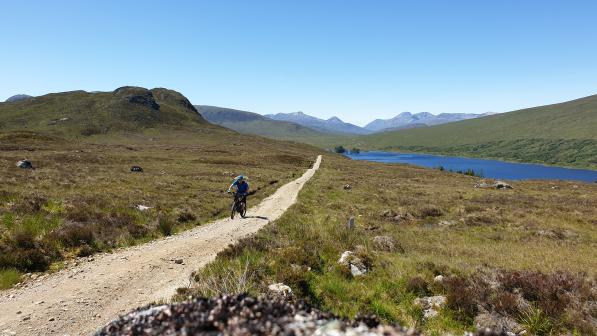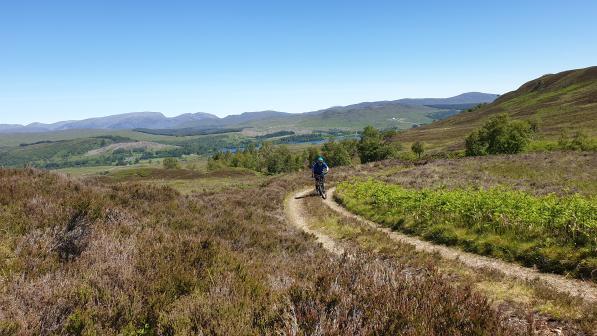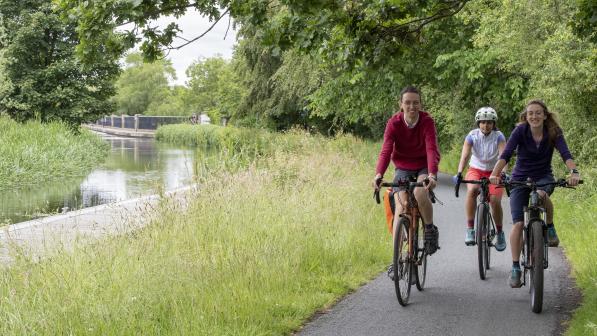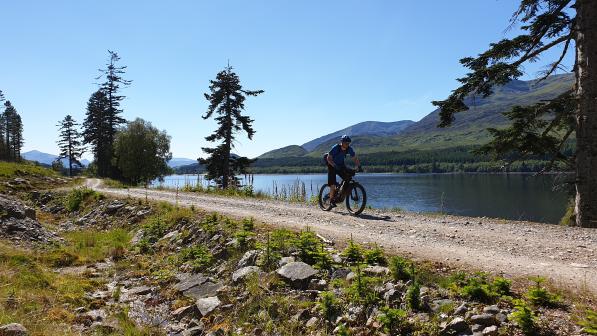Great North Trail Part 6: Grampian Mountains

Part 6 of Cycling UK's Great North Trail, an off-road route from the Peak District to Cape Wrath or John o' Groats.
See places to stay, eat and visit in the full route guide
Best for
Remote and wild rides through the Scottish hillsides
Wild weekends away
Point-to-point rides using trains to move around
Area and route
In Glasgow, the Great North Trail joins the recently developed ‘An Turas Mor’ (Scottish Gaelic for ‘the long journey’), developed by Obscura Mondo Cycle Club.
To leave Glasgow, you’ll follow pretty riverside paths before heading off onto the trails.
Climbing high, the route links together various back-country tracks, national cycle routes, forest and estate tracks, drove and quiet roads.
You’ll cover huge distances, riding through very remote, wild landscapes including mountain passes (don’t get caught out by hazardous weather – wind and snow at the top of the mountain passes might delay you for days, and headwinds channelled through the valley bottoms can be morally destroying). This makes this section physically tough, although the gravel tracks are very rideable (nevertheless, the Corrieyairack Pass will probably defeat many people).
Otherwise, picturesque loch-side tracks, little beaches, stunning views, a legendary monster and just enough facilities (cafes and accommodation) along the way, give it the perfect amount of adventure.
This section finishes at Fort Augustus – the southern end of Loch Ness – right in the heart of Scotland.

Useful info
Scotland is an off-road cyclists haven. Not only has the Land Reform (Scotland) Act 2003 given riders the same rights of access rights as walkers, but also the 18th century military roads and hydro-electric schemes have created hundreds of miles of good tracks across the hills and mountains, enabling cyclists to travel all over the Scottish Highlands, largely avoiding roads.
Access Code – while the Land Reform Act gives mountain bikers the same rights of access to the outdoors as walkers, it also makes users responsible for knowing and abiding by the 'Access Code'. See ‘Do the Ride Thing' www.dmbins.com/riders/do-the-ride-thing
Mobile phone coverage is intermittent in the Highlands, so an EPIRB (emergency position-indicating radio beacon) is recommended, especially if riding solo.
Deer stalking – the (red deer) season runs from the start of July to mid-February, so you should check www.deer-management.co.uk for information on dates and whereabouts of shoots.
Wild camping is allowed in most places within Scotland, but due to the popularity of the Trossachs and Loch Lomond National Park, there are now ‘camping management zones’ in force, restricting the act of wild camping in certain areas.
Bothies are traditional, roofed shelters in the mountains, many gifted to the charity ‘The Mountain Bothy Association’ (MBA), who maintain and protect them. Most bothies are open and free to use, but don’t expect any facilities, follow the rules and be aware that they are becoming more popular and could be full when you arrive.
Navigation
The route is pretty easy to navigate because there aren’t very many options. Once you have found the correct track off roads or when exiting towns, it is usually a case of following the main track for a number of kms until you reach something, or anything, else.
You may also see a few ‘Au Turas Mor’ stickers up along the route, which will also confirm you are on the right track.
Difficulty rating
The following ratings use the colour-coded mountain bike trail grading system - see here for an explanation. We have added a Purple grade which refers to Red technical difficulty plus remoteness, where experience of the outdoors is required. They are intended as a guide only, to help you decide which sections are best for you:
Green: Glasgow to Maryhill
Blue/(Red): Maryhill to Drymen (short 0.5km Red section at B821/Arlehaven.
Blue: Drymen to Falls of Leny
Green: Falls of Leny to Strathyre
Blue: Strathyre to Balquhidder
Green/(Blue): Balquhidder (the short climb up the hill at the start is Blue) to Lochan Lairig Cheile
Blue: Lochan Lairig Cheile to Kenknock (past Killin)
Red: Kenknock to the top of the pass
Blue: down from the pass to Bridge of Balgie, and from there to Rannoch station
Purple: Rannoch station to Fort Augustus
These ratings use the mountain bike trail grading system - see here for an explanation. Difficulty ratings are intended as a guide only, to help you decide which sections are best for you.
© 2019 Cyclists Touring Club trading as Cycling UK. All rights reserved.



